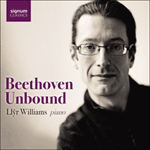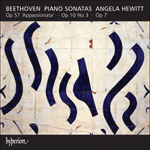
Welcome to Hyperion Records, a British classical label devoted to presenting high-quality recordings of music of all styles and from all periods from the twelfth century to the twenty-first.
Hyperion offers both CDs, and downloads in a number of formats. The site is also available in several languages.
Please use the dropdown buttons to set your preferred options, or use the checkbox to accept the defaults.

| Llŷr Williams (piano)» More |
The Allegro third movement returns us to playful mood in a less sophisticated manner than Op 10 No 3 but is full of humour and charm. Its middle section, in E flat minor, is made up of rumbling triplets that contrast totally with what has come before. The colour of this passage would probably have sounded very different on Beethoven’s piano than on most modern instruments, and I think we need to keep that in mind when playing it. The fourth pedal on my Fazioli piano which I used for this recording works wonders here, bringing the hammers closer to the strings while at the same time lowering the keys so that the action is much shallower, enabling a swift, clear, and yet quiet execution.
As Tovey has suggested, if the first movement of this sonata looks forward to a new style of writing, the finale, Poco allegretto e grazioso, is one of the last examples of his early style. The Rondo melody is a long, meandering one which lends itself easily to ornamentation. Its charm is broken, however, by the middle section in C minor, which suddenly takes off using what was an accompanying figure to propel it forward (Czerny says this section can be taken a bit faster than the rest). When the Rondo theme returns it is as if nothing has happened, and the movement ends in the most unassuming way. Perhaps if it ended loudly this piece would be performed more often. Beethoven dedicated this sonata to one of his piano students, the Countess Babette von Keglevics, who lived not far away at the time; Beethoven often turned up at her house for lessons still wearing his slippers, dressing gown, and a peaked nightcap.
from notes by Angela Hewitt © 2006
Avec moins de sophistication que dans l’op. 10 no 3, le troisième mouvement Allegro nous replonge dans un climat enjoué, mais plein d’humour et de charme. Sa section médiane, en mi bémol mineur, est faite de triolets grondants, aux antipodes de ce qui s’est passé jusqu’alors. La couleur de ce passage aurait certainement été tout autre sur le piano de Beethoven, et il me semble qu’il faut y penser quand on joue. La quatrième pédale du piano Fazioli que j’ai utilisé pour cet enregistrement fait ici des merveilles, rapprochant les marteaux des cordes tout en abaissant les touches, si bien que la mécanique, bien moins profonde, permet une exécution rapide, claire et, malgré tout, tranquille.
Comme l’a suggéré Tovey, autant le premier mouvement de cette sonate regarde vers un nouveau style d’écriture, autant le finale, Poco allegretto e grazioso, est l’un des derniers exemples du style ancien de Beethoven. La mélodie du Rondo, longue et sinueuse, se prête volontiers à l’ornementation. Son charme est cependant rompu par la section médiane en ut mineur, qui décolle soudain en se propulsant à l’aide d’une figure accompagnante (Czerny dit que l’on peut aborder cette section un peu plus vite que le reste). Quand le thème du Rondo revient, c’est comme si rien ne s’était passé, et le mouvement s’achève en toute modestie. Peut-être cette pièce serait-elle jouée plus souvent si elle se terminait bruyamment. Beethoven la dédia à l’une de ses élèves pianistes, la comtesse Babette von Keglevics, qui habitait alors non loin de chez lui—que de fois il se présenta chez elle en pantoufles, robe de chambre et bonnet de nuit, pour lui donner des leçons.
extrait des notes rédigées par Angela Hewitt © 2006
Français: Hyperion Records Ltd
Der dritte Satz Allegro kehrt zwar auf weniger raffinierte Art und Weise als im op. 10 Nr. 3 in eine verspielte Stimmung zurück, ist aber voll Humor und Charme. Der in es-Moll angelegte Mittelteil besteht aus grollenden Triolen, die in vollkommenem Kontrast zu allem Vorhergegangenen stehen. Auf Beethovens Klavier wird die Klangfarbe dieser Stelle wohl ziemlich anders gewirkt haben als auf den meisten modernen Instrumenten, was der heutige Spieler meiner Meinung nach berücksichtigen sollte. Das vierte Pedal des von mir für diese Einspielung verwendeten Fazioli-Flügels wirkt hier Wunder, da er die Hämmer näher an die Saiten bringt und gleichzeitig die Tastatur senkt, so daß der Anschlag viel flacher wird, was eine schnelle, klare und dennoch leise Spielart ermöglicht.
Tovey merkte bereits an, daß, während der erste Satz dieser Sonate auf einen neuen Kompositionsstil vorausblickt, das Finale, Poco allegretto e grazioso, eines der letzten Beispiele für Beethovens frühen Stil darstellt. Die Melodie des Rondos ist lang und weitschweifig und bietet sich für Verzierungen geradezu an. Ihr Charme wird jedoch durch den Mittelteil in c-Moll unterbrochen, der plötzlich, von einer vorher der Begleitung dienenden Figur vorangetrieben, in Fahrt kommt (laut Czerny darf dieser Teil etwas schneller gespielt werden als der Rest). Wenn das Rondothema wiederkehrt, scheint es, als sei nichts passiert, und der Satz endet auf sehr unauffällige Art und Weise. Vielleicht würde das Stück öfter zur Aufführung kommen, wenn es über einen fulminanteren Schluß verfügte. Beethoven widmete die Sonate einer seiner Klavierschülerinnen, Gräfin Babette von Keglevics, die zu der Zeit nicht weit von ihm entfernt wohnte; oft erschien Beethoven zum Unterricht bei ihr zu Hause noch in Hausschuhen, Morgenmantel und mit zipfeliger Schlafmütze.
aus dem Begleittext von Angela Hewitt © 2006
Deutsch: Bettina Reinke-Welsh
 Beethoven: Beethoven Unbound Beethoven: Beethoven UnboundA comprehensive new cycle of the Beethoven sonatas recorded live at London's Wigmore Hall during the pianist's epic fourth rendition of these masterpieces .» More |
 Beethoven: Piano Sonatas Opp 10/3, 7 & 57 Beethoven: Piano Sonatas Opp 10/3, 7 & 57 |

